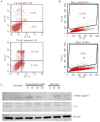Regulation of paclitaxel-induced programmed cell death by autophagic induction: A model for cervical cancer
- PMID: 24327986
- PMCID: PMC3784092
- DOI: 10.5468/OGS.2013.56.2.84
Regulation of paclitaxel-induced programmed cell death by autophagic induction: A model for cervical cancer
Abstract
Objective: Autophagy plays a vital role in homeostasis by combining organelles and cellular proteins with lysosome under starvation conditions. In addition, autophagy provides tumor cells with a source of energy. Continued autophagy will induce cells death. Here we aim to see if autophagic induction has an effect on conventional chemotherapeutic agents.
Methods: Rapamycin, or mammalian target of rapamycin and paclitaxel, apoptosis-inducing agents were used autophagy in HeLa cervical cancer cells.
Results: Growth inhibition of cells was not observed after the application of 0, 10, 20 nM of paclitaxel with or without rapamycin. Using a 5 nM concentration of paclitaxel, rapamycin administration inhibited cell growth significantly compared to no treatment. This implies the synergic antitumor effect of paclitaxel and rapamycin. Paclitaxel itself did not show any autophagic effect on cells but did show cell apoptosis by flow cytometry. Light chain 3, a microtubule-associated protein, which reflect autophagy, was increased with 5 nM of paclitaxel after pretreatment with 10 nM of rapamycin.
Conclusion: These findings suggest that the autophagic inducer, rapamycin, can potentiate autophagic cell death when added as an apoptosis-inducing chemotherapeutic agent. In conclusion, the control of autophagy may be a future target for chemotherapy.
Keywords: Apoptosis; Autophagy; Cervical neoplasms; Paclitaxel; mTOR protein.
Figures



Similar articles
-
Autophagy inhibition promotes paclitaxel-induced apoptosis in cancer cells.Cancer Lett. 2011 Aug 28;307(2):141-8. doi: 10.1016/j.canlet.2011.03.026. Epub 2011 Apr 21. Cancer Lett. 2011. PMID: 21511395
-
Inhibition of the mammalian target of rapamycin (mTOR) by rapamycin increases chemosensitivity of CaSki cells to paclitaxel.Eur J Cancer. 2006 May;42(7):934-47. doi: 10.1016/j.ejca.2005.12.018. Epub 2006 Mar 15. Eur J Cancer. 2006. PMID: 16540312
-
Inhibition of the mammalian target of rapamycin leads to autophagy activation and cell death of MG63 osteosarcoma cells.Oncol Lett. 2013 Nov;6(5):1465-1469. doi: 10.3892/ol.2013.1531. Epub 2013 Aug 16. Oncol Lett. 2013. PMID: 24179542 Free PMC article.
-
Therapeutic strategies of drug repositioning targeting autophagy to induce cancer cell death: from pathophysiology to treatment.J Hematol Oncol. 2017 Mar 9;10(1):67. doi: 10.1186/s13045-017-0436-9. J Hematol Oncol. 2017. PMID: 28279189 Free PMC article. Review.
-
Autophagy and apoptosis in liver injury.Cell Cycle. 2015;14(11):1631-42. doi: 10.1080/15384101.2015.1038685. Cell Cycle. 2015. PMID: 25927598 Free PMC article. Review.
Cited by
-
Mechanism of miR-218-5p in autophagy, apoptosis and oxidative stress in rheumatoid arthritis synovial fibroblasts is mediated by KLF9 and JAK/STAT3 pathways.J Investig Med. 2021 Feb 8;69(4):824-32. doi: 10.1136/jim-2020-001437. Online ahead of print. J Investig Med. 2021. PMID: 33558275 Free PMC article.
-
Halofuginone Synergistically Enhances Anti-Proliferation of Rapamycin in T Cells and Reduces Cytotoxicity of Cyclosporine in Cultured Renal Tubular Epithelial Cells.PLoS One. 2015 Dec 15;10(12):e0144735. doi: 10.1371/journal.pone.0144735. eCollection 2015. PLoS One. 2015. PMID: 26671563 Free PMC article.
-
MiR-218 inhibits HMGB1-mediated autophagy in endometrial carcinoma cells during chemotherapy.Int J Clin Exp Pathol. 2015 Jun 1;8(6):6617-26. eCollection 2015. Int J Clin Exp Pathol. 2015. PMID: 26261543 Free PMC article.
-
Combination of pristimerin and paclitaxel additively induces autophagy in human breast cancer cells via ERK1/2 regulation.Mol Med Rep. 2018 Nov;18(5):4281-4288. doi: 10.3892/mmr.2018.9488. Epub 2018 Sep 14. Mol Med Rep. 2018. PMID: 30221728 Free PMC article.
-
miR-17-5p downregulation contributes to paclitaxel resistance of lung cancer cells through altering beclin1 expression.PLoS One. 2014 Apr 22;9(4):e95716. doi: 10.1371/journal.pone.0095716. eCollection 2014. PLoS One. 2014. PMID: 24755562 Free PMC article.
References
-
- Kondo Y, Kanzawa T, Sawaya R, Kondo S. The role of autophagy in cancer development and response to therapy. Nat Rev Cancer. 2005;5:726–734. - PubMed
-
- Kondo Y, Kondo S. Autophagy and cancer therapy. Autophagy. 2006;2:85–90. - PubMed
-
- Tewari KS, Monk BJ. Recent achievements and future developments in advanced and recurrent cervical cancer: trials of the Gynecologic Oncology Group. Semin Oncol. 2009;36:170–180. - PubMed
-
- Liang XH, Jackson S, Seaman M, Brown K, Kempkes B, Hibshoosh H, et al. Induction of autophagy and inhibition of tumorigenesis by beclin 1. Nature. 1999;402:672–676. - PubMed
-
- Pattingre S, Tassa A, Qu X, Garuti R, Liang XH, Mizushima N, et al. Bcl-2 antiapoptotic proteins inhibit Beclin 1-dependent autophagy. Cell. 2005;122:927–939. - PubMed
LinkOut - more resources
Full Text Sources
Other Literature Sources
Miscellaneous

